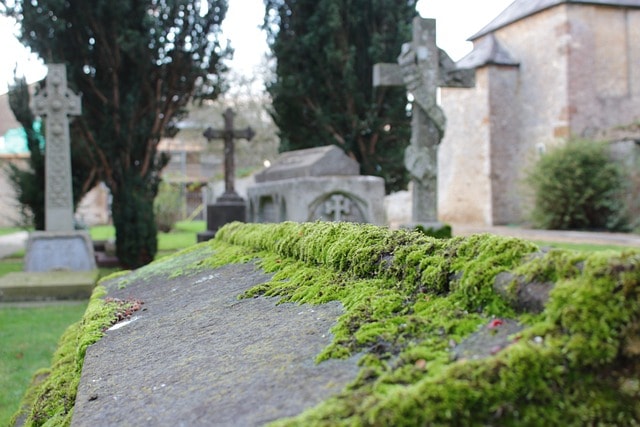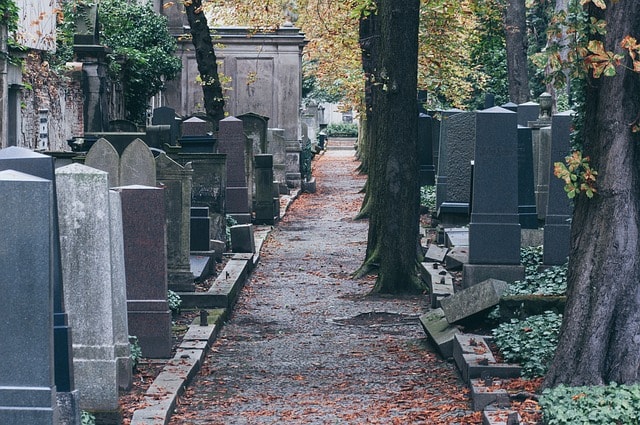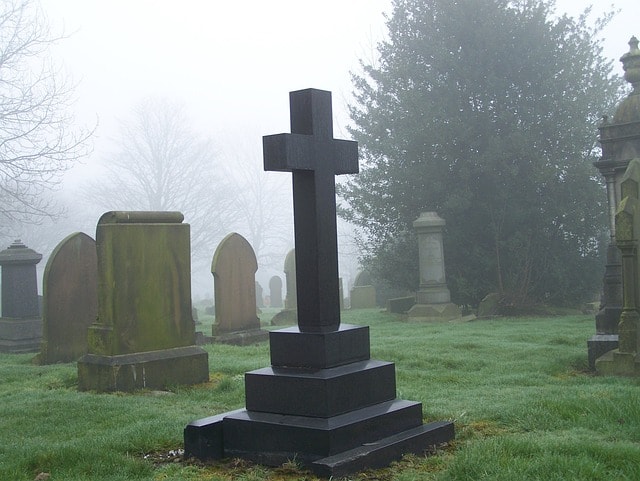When deciding on a final resting place, many people use the terms "graveyard" and "cemetery" interchangeably. However, these two types of burial grounds have distinct histories, spaces, and practices that set them apart. Whether you're visiting older graves of loved ones, planning a burial site for yourself, or simply exploring the rich traditions, understanding the differences can help guide your decisions.
This blog will unpack the differences between a graveyard and a cemetery, their origins, key features, and practical considerations to help you make an informed choice.

Definition and Origins of Graveyards and Cemeteries
Church Graveyards
The term “graveyard” originates from the proto-Germanic word “graban,” meaning “to dig,” and “garden,” referring to an enclosed area. Historically, graveyards are closely tied to churches and are often located within churchgrounds. Early Christians generally interred people’s mortal remains in these sacred spaces, often near or around a specific church.
Graveyards became synonymous with small, tightly packed burial areas used for religious communities. Many churches established these burial grounds. However, church graveyards filled up due to rapid population growth in the early 19th century, leading to the emergence of cemeteries as designated burial grounds, distinguishing them from traditional graveyards that were often located adjacent to churches.
Cemeteries
The word “cemetery” has roots in the Greek word koimeterion, which means "dormitory" or "sleeping chamber." Unlike graveyards, cemeteries are not tied to a particular church or religious establishment. Emerging as population growth and urbanization strained existing church graveyards, cemeteries provided new, organized burial grounds outside crowded towns and city centers.
Many cemeteries, especially those established during the Industrial Revolution, were designed with more space and accessibility in mind. Some transformed into garden cemeteries or public parks, offering serene spaces for reflection.
Key Differences:
-
Graveyards are traditionally part of church property, tied to specific churches.
-
Cemeteries are larger, often secular, and situated outside city limits or urban areas.

Historical Context
Burial Traditions in the Middle Ages
During the Middle Ages, influential Christians and wealthy congregants were typically buried inside churches, often in crypts or beneath the church floor. Less wealthy congregants were generally interred outside within the churchyard. This differentiation highlighted socioeconomic distinctions even within burial practices.
However, as churchyards began to fill, overflow issues led to the creation of new burial grounds away from church property. These new burying grounds eventually evolved into modern cemeteries—structured, inclusive spaces designed to accommodate a broader population.
The Rise of Urban Cemeteries
Rapid urbanization brought unique challenges in the 18th and 19th centuries. With city centers expanding and the population growing, burial sites within towns became unsustainable. Urban cemeteries emerged as a practical solution, offering neatly divided spaces, modern family plots, and designated final resting places removed from the urban sprawl.
Additionally, these cemeteries often had a dual purpose. Designed as garden or rural cemeteries, they served as peaceful spaces resembling public parks, where families could visit their loved ones while enjoying green, undeveloped land.
Takeaway: While historical graveyards were limited to church members and particular religions, urban cemeteries were created to serve a diverse population, including individuals from different faiths.

Key Differences Between Graveyards and Cemeteries
Space and Layout
-
Graveyards are typically smaller, confined to church grounds, and often laid out without a formal structure. Space constraints limit modern family plots, and grave sites may appear less organized.
-
Cemeteries, in contrast, are intentionally designed, offering more space and distinct areas for various types of burials, including cremated remains, traditional burials, and headstone memorials. Their layouts often reflect thoughtful city planning, with neatly divided sections and walking paths. The cost of a burial plot remains consistent across various cemeteries, addressing the legal and administrative requirements surrounding burial sites.
Headstones and Memorials
-
Graveyards often adhere to stricter rules about headstones and memorials, favoring traditional designs that align with religious values.
-
Cemeteries tend to allow for greater creativity. Families can personalize memorials with inscriptions, unique headstone designs, or even custom elements that reflect the deceased’s personality.
By offering flexible burial options, cemeteries appeal to families seeking a more modern approach.

Cultural and Religious Significance
The cultural and religious significance of burial grounds cannot be overstated. These sacred spaces have played a crucial role in the spiritual and emotional lives of people across various cultures and faiths. In many religions, cemeteries are considered hallowed grounds where the deceased are laid to rest, and the living can pay their respects and seek solace.
In Christianity, for example, cemeteries symbolize eternal life, where the deceased await resurrection. The word cemetery itself, derived from the Greek koimeterion, meaning “sleeping chamber,” reflects this belief in a peaceful rest before the afterlife. In Islam, cemeteries are revered places where the deceased are buried facing Mecca, emphasizing the importance of spiritual orientation even in death. Jewish cemeteries, on the other hand, are places of mourning and remembrance, where simplicity and humility are paramount, often marked by modest headstones.
Cemeteries and graveyards also mirror the cultural and historical context of their communities. Victorian-era cemeteries, with their grand and ornate monuments, reflect the social status and wealth of the deceased, showcasing the era’s values and aesthetics. In contrast, Quaker cemeteries, characterized by their simplicity and austerity, embody the values of humility and equality, eschewing elaborate markers for plain, unadorned stones.

Practical Considerations
Cost and Ownership
-
Graveyard Burial Costs
Prices often depend on factors like the location of the church property and available space. Since graveyards are smaller and older, burial plots may cost less in rural areas but could be more expensive in urban churchyards due to limited availability.
-
Cemetery Burial Costs
Cemeteries typically price burial plots based on size, location, and amenities (e.g., perpetual care services). Many offer options for purchasing individual or family plots, with the flexibility to transfer ownership.
Ownership often extends for 50-100 years, though some cemeteries allow perpetual ownership. Consulting local authorities or a funeral director can help when comparing costs.
Management and Maintenance
The management and maintenance of cemeteries and graveyards are crucial to preserving their dignity and respect. Cemetery authorities are tasked with a range of responsibilities, from allocating land for burial plots to digging and filling graves, and maintaining the grounds and landscaping.
Beyond these practical tasks, cemetery authorities must balance the needs of different stakeholders, including the families of the deceased, the local community, and the environment. This often involves implementing sustainable practices, such as using eco-friendly materials and reducing waste, to ensure that burial grounds remain respectful to both the deceased and the planet. Additionally, authorities must ensure that cemeteries are accessible and welcoming to visitors, providing amenities like seating, lighting, and restrooms.
Complex issues such as the reuse of graves, the relocation of cemeteries, and the management of cremated remains require careful consideration. These decisions must take into account cultural, religious, and environmental factors, as well as consultation with stakeholders and the wider community. By navigating these challenges thoughtfully, cemetery authorities can maintain the integrity and sanctity of these sacred spaces.
Visitation and Accessibility
Visitation and accessibility are essential aspects of cemetery and graveyard management. These spaces are not just places of burial but also areas for remembrance, reflection, and connection with the deceased.
Cemetery authorities must ensure that visitors can access the cemetery safely and easily, regardless of their age or ability. This may involve installing pathways, ramps, and other accessibility features, as well as providing amenities such as seating, lighting, and restrooms. By prioritizing these elements, cemeteries can become inclusive spaces that welcome all visitors.
Clear communication of visitation hours and rules is also crucial. Visitors should be informed of any restrictions on activities such as photography, picnicking, or other behaviors that might disrupt the peace and sanctity of the burial grounds. Additionally, educational programs and guided tours can help visitors understand the history, culture, and significance of the cemetery, enriching their experience.
Balancing the needs of visitors with the need to maintain the dignity and respect of the deceased is paramount. Implementing rules and regulations around behavior, dress code, and other aspects of visitation ensures that cemeteries remain respectful and serene environments. By focusing on visitation and accessibility, cemetery authorities can create a welcoming and inclusive atmosphere that honors both the deceased and the living.
Visitation and Maintenance
Both graveyards and cemeteries may differ in their visitation policies and maintenance practices.
-
Graveyards often rely on church congregations to manage the upkeep of burial sites.
-
Cemeteries, especially urban cemeteries, employ staff or third-party services for regular maintenance, ensuring that burial grounds remain pristine. Some cemeteries offer subscription-based services, like seasonal flower arrangements for loved ones’ graves.
Making a Decision
Deciding whether to choose a cemetery and a graveyard depends on several factors, including:
-
Personal Beliefs – Religious affinities or connection to a particular church.
-
Preferred Atmosphere – Intimate graveyards vs. tranquil garden cemeteries.
-
Family Considerations – Proximity to other family members’ burial sites.
-
Cost – Research burial costs and ownership terms in your area.
-
Space Requirements – Consider modern family plots or options for cremated remains.
Consulting a funeral director can also help clarify these options.

Choosing Between Graveyards and Cemeteries
Ultimately, the choice between a graveyard and a cemetery is a deeply personal and emotional one. Whether it's the sacred traditions of a churchyard burial or the serene beauty of a rural cemetery, each option offers unique ways to celebrate the lives of loved ones.
By understanding historical, practical, and emotional aspects, individuals can find a final resting place that honors their values and memories.

Fort Snelling Cemetery
To order cemetery flowers for Fort Snelling Cemetery, please visit the Fort Snelling Cemetery Flowers website. They offer a wide selection of beautiful and respectful floral arrangements specifically designed for honoring and remembering loved ones at Fort Snelling Cemetery. Browse through their collection and choose the perfect flowers to pay tribute to your cherished ones in this hallowed ground.
Resources for Graveyards and Cemeteries
Here are some valuable resources to explore for more information on graveyards and cemeteries:
-
National Funeral Directors Association - The NFDA provides extensive resources on funeral planning, burial options, and cemetery guidelines.
-
Funeral Consumers Alliance - The Funeral Consumers Alliance offers guidance on funeral and cemetery choices, including information on pricing, consumer rights, and environmentally friendly options.
-
Find a Grave - This online database allows you to search for graveyards and cemeteries around the world. It provides information on famous gravesites, genealogy research, and virtual memorials.
-
Association for Gravestone Studies - The AGS is dedicated to the preservation and study of gravestones and burial grounds. Their website offers resources, publications, and events related to cemetery history and conservation.
-
The Green Burial Council - If you are interested in eco-friendly burial options, the Green Burial Council offers resources and certification for environmentally sustainable practices in graveyards and cemeteries.
-
BillionGraves - BillionGraves is a collaborative platform that aims to digitally preserve the world's cemeteries. Through the use of GPS technology and crowdsourcing, users can contribute by taking photos of headstones and uploading them to the database. This valuable resource allows individuals to access and preserve cemetery records from various locations around the globe.
These resources can guide you in making informed decisions and assist you in navigating the options and considerations associated with graveyards and cemeteries.

